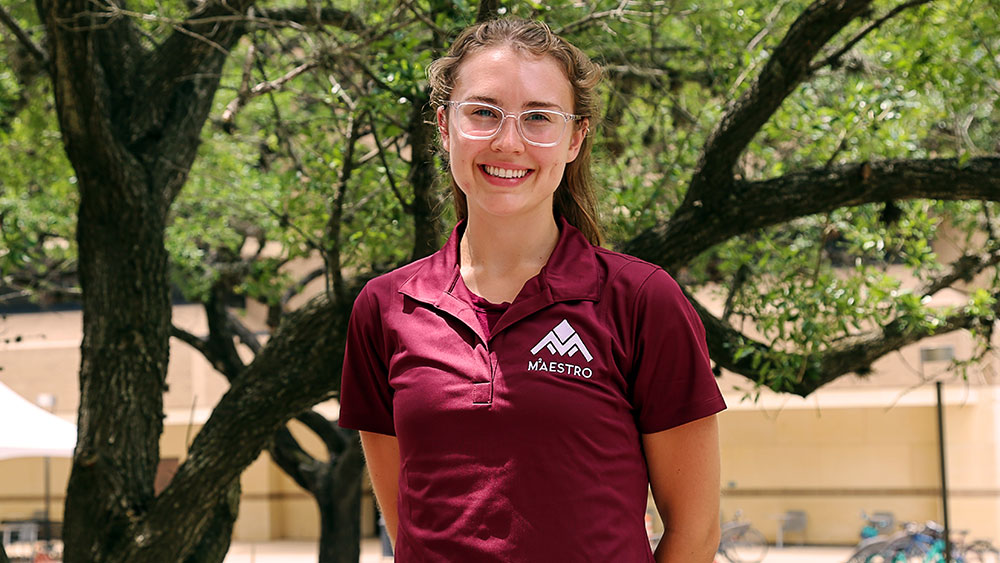
When she was 10 years old, Collette Gillaspie caught her first glimpse of a future on Mars. While visiting a nature and science museum during a family road trip, Gillaspie was mesmerized by an exhibit about a Martian habitat, memorizing all the bite-sized facts the information display had to offer and letting her mind imagine what it would be like to visit the red planet. Today, she’s a doctoral student studying aerospace engineering at Texas A&M University and conducting research related to habitats and getting humans to the moon and Mars sustainably.
An early introduction to the wonders of STEM (science, technology, engineering and mathematics) inspired Gillaspie’s interests and education, and she’s found a way to spark that same enthusiasm for a group of fourth graders in her home state of Nebraska by embracing the virtual learning environment.
After giving a virtual presentation to young students during a Women in Science and Engineering (WiSE) event, Gillaspie reached out to a cousin-in-law who teaches elementary with an idea. Together, they set up a virtual learning opportunity for the fourth graders at Plattsmouth Elementary School to learn from students at Texas A&M.
“It’s just been so difficult to get everyone excited about science and engineering and mathematics during this time,” said Gillaspie. “I really want this experience to give them a glimpse of STEM and some topics they might not otherwise be exposed to.”
Gillaspie organized about 15 Texas A&M engineering students to deliver a 30-minute presentation with a 15-minute Q&A once a week to a class. Using Nebraska’s science standards as a guide, the volunteers presented topics like electricity, heredity traits, motion and forces, rocks and engineering design.
According to Gillaspie’s cousin-in-law, Stephanie Icenogle – Mrs. Ice to the fourth graders – the class has had a blast learning from new faces, or as she says, “not the same boring teachers.”
“It’s just really fun to see them get really excited about the different topics and all raise their hands at once to answer a question,” said Gillaspie. “I’m just so impressed by how easy it was to interact with them and how willing they were to learn.”
The fourth graders were eager to meet the student presenters every week and never short of questions. One class thought Gillaspie and a fellow graduate student were siblings because they both presented about a space topic, so with the fervor of a 9 year old, they asked him the same questions they asked Gillaspie to “test him to see if he also knows the answers.”
The 45-minute commitment of a few Aggies has reinvigorated the learning space for these young students after the pandemic uprooted the structure of school. Gillaspie said she doesn’t think she would have had the idea had it not been for the circumstances of the pandemic, but the experience has been rewarding for everyone involved.
“With kids, there just seems to be this innate love of learning and curiosity,” said Gillaspie. “I think doing experiences like these and volunteering with kids who are excited to learn is the best motivation for bringing back your natural curiosity and getting excited to learn again.”
A native Nebraskan, Gillaspie made unique connections to the lessons by incorporating experiences the fourth graders would be familiar with. When she was in high school, she worked at Omaha’s Henry Doorly Zoo and Aquarium, so during her presentation on different environments and ecosystems, she created a fun connection for the class by referencing the local zoo and its makeup.
“You can definitely tell when someone understands something, and it clicks in their head, and to be able to see that as a teacher, the light bulb go off, it’s priceless,” said Gillaspie.
When she decided to go to graduate school, she had a soft goal of becoming a professor. That goal has been kindled by opportunities like this volunteer experience and being a teaching assistant in the department, along with her own experiences learning from advisors through human spaceflight research and a NASA Tipping Point project. It’s now her long-term goal to stay in academia to teach and conduct research with students, guiding them through their academic success and helping them realize their own interests.
“I think professors have just a really special job, to enable this next generation of scientists and doctors and engineers and inventors and people who change the world,” said Gillaspie. “What a humbling experience to enable that growth for another person.”
With the help of Texas A&M College of Engineering student organizations, Gillaspie is furthering that growth opportunity for current students interested in volunteering to teach topics to the fourth grade classes. What started as a spark of motivation in Gillaspie has now developed into a full outreach opportunity for students involved in WiSE, the Society of Women Engineers, the Society of Women in Space Exploration and student teachers.
“It’s an exciting experience to be able to instill that passion that you have for a subject into a fourth grader,” said Gillaspie. “You can’t beat it.”